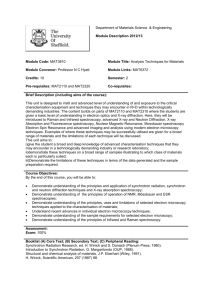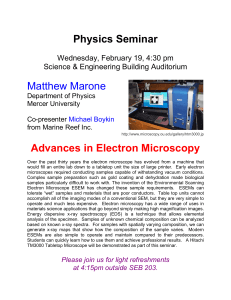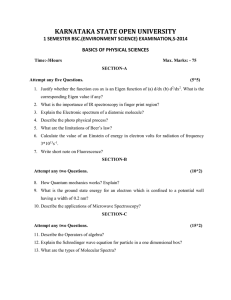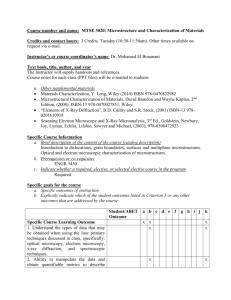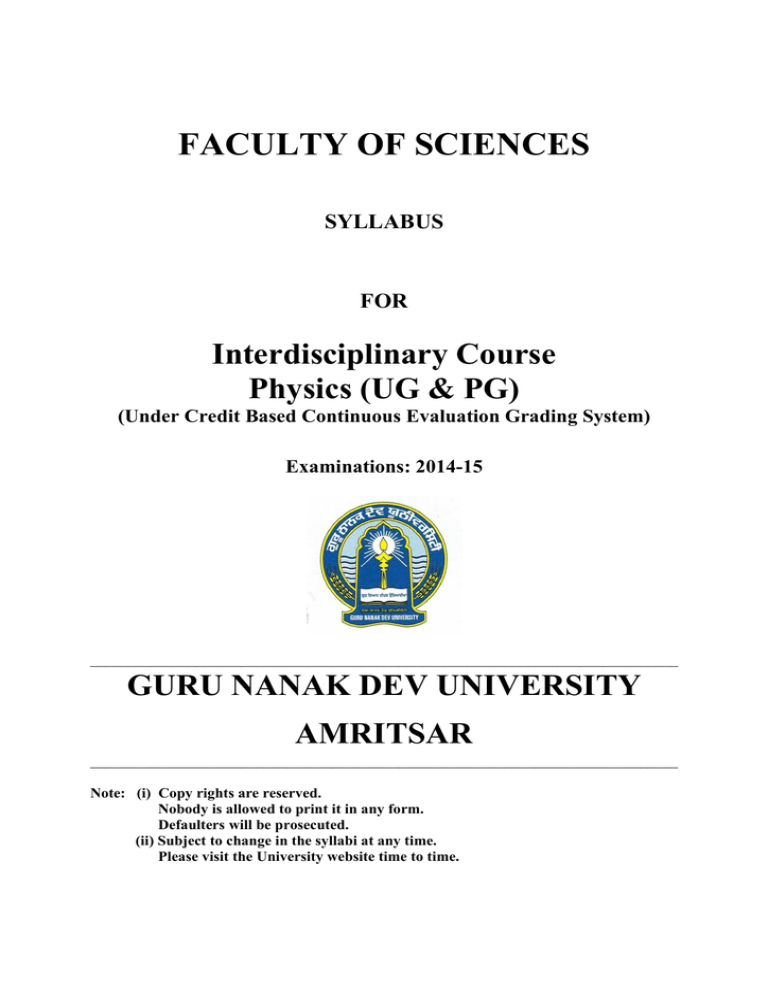
FACULTY OF SCIENCES
SYLLABUS
FOR
Interdisciplinary Course
Physics (UG & PG)
(Under Credit Based Continuous Evaluation Grading System)
Examinations: 2014-15
______________________________________________________________________________
GURU NANAK DEV UNIVERSITY
AMRITSAR
______________________________________________________________________________
Note: (i) Copy rights are reserved.
Nobody is allowed to print it in any form.
Defaulters will be prosecuted.
(ii) Subject to change in the syllabi at any time.
Please visit the University website time to time.
1
Interdisciplinary Courses
PHYSICS (UG & PG)
GENERAL PHYSICS-I (UG)
(Odd Semester)
Course No.
PHL-001
LTP
300
Electrostatics : Electric Charges; Coulomb's law, forces between multiple charges; Electrical
field, electric field due to a point charge, electric-field lines; electric dipole, torque on a dipole in
uniform electric field. Electric flux, Gausss's theorem and its applications to find field due to
infinitely long straight wire, uniformly charged infinite plane sheet and uniformly charged thin
spherical shell; Electric potential, potential difference, electric potential due to a point charge and
system of charges; electrical potential energy of a system of charges. Capacitors and capacitance,
combination of capacitors, capacitance of a parallel plate capacitor, energy stored in a capacitor.
Electric current, drift velocity, mobility, Ohm's law, electrical resistance, electrical energy and
power, electrical resistivity and conductivity, combinations of resistors; temperature dependence
of resistance, Superconductor
Magnetostatics: Concept of magnetic field, Biot-savart law and its application, Ampere's law
and its applications, Force on a moving charge in uniform magnetic and electric fields. Force on
a current-carrying conductor in a uniform magnetic field, Force between two parallel currentcarrying conductors, definition of ampere, Electromagnetic induction, Faraday's laws, induced
emf and current, Lenz's Law.
Electronic Devices: Semiconductors, Intrinsic/Extrinsic semiconductor, P.N. Junction,
Characteristic of p n junction diode, pn junction as rectifier, zener diode and its characteristics,
photodiode, LED and solar cells, Integrated Circuits, Bipolar junction transistor, CB, CE, CC
configuration, Transistor as amplifier, oscillator and switch, logic gates: AND,OR, NOT,
NAND, NOR, XOR.
Text and Reference Books:
1. Fundamentals of Physics 8th Edition: Resnick Halliday Walker
2. University Physics 12th Edition: Hugh D. Young , Roger A. Freedman , Lewis Ford
3. Concepts of Physics: H. C. Verma
4. Electrodynamics: Grifths
5. Integrated Electronics: J.Millman and C.C.Halkias
6. Digital Principles & Applications: P. Malvino & Leach
2
Interdisciplinary Courses
PHYSICS (UG & PG)
GENERAL PHYSICS-II (UG)
(Even Semester)
Course No.
PHL-002
LTP
300
1. Quantum Mechanics: Wave-particle dualitiy; Schroedinger equation and expectation
values; Uncertainty principle; Solutions of the one-dimensional Schroedinger equation
for a free particle, particle in a box, particle in a finite well, linear harmonic oscillator;
Reflection and transmission by a step potential and by a rectangular barrier; Particle in a
three dimensional box.
2. Atomic and Molecular Physics: Stern-Gerlach experiment, electron spin, fine structure
of hydrogen atom; L-S coupling, J-J coupling; Spectroscopic notation of atomic states;
Zeeman effect; Elementary theory of rotational, vibratonal and electronic spectra of
diatomic molecules; Raman effect and molecular structure; Raman spectroscopy.
3. Solid State Physics: Crystalline and amorphous structure of matter; Different crystal
systems, space groups; Methods of determination of crystal structure; X-ray diffraction,
scanning and transmission electron microscopies; Thermal properties of solids, specific
heat, Debye theory, Magnetism: dia, para and ferromagnetism; Elements of
superconductivity, Meissner effect, BCS theory,
Elementary ideas about high
temperature superconductivity.
Text and Reference Books:
1. Concepts of Modern Physics - Arthur Beiser
2. Quantum Mechanics - P T Mathews
3. Introduction to Quantum Theory -R Dicke and J Wittke
4. Quantum Mechanics - Ghatak and Loknatham
5. Introduction to Atomic Spectra - H. E. White
6. Atomic Spectra and Atomic Structure by Gerhard Herzberg
7. An Introduction to Solid State Physics - C. Kittel.
8. Solid State Physics - A.J. Dekkar.
3
Interdisciplinary Courses
PHYSICS (UG & PG)
CHARACTERIZATION TECHNIQUES (PG)
(Even or Odd Semester)
Course No.
PHL-051
LTP
300
Scanning electron microscopy, Transmission electron microscopy, Scanning tunneling
microscopy, Atomic force microscopy, Optical microscopy.
X-ray diffraction, data manipulation of diffracted X-rays for structure determination; X-ray
fluorescence spectrometry for element detection with concentration; Auger electron spectroscopy
(AES), X-ray photoelectron spectroscopy (XPS), Secondary ion mass spectroscopy (SIMS)
techniques for the analysis of surfaces, DTA, TGA and DSC measurements and analysis of the
curves.
Infrared, ultra-violet, visible and Raman spectroscopy. Electrical measurements: Two probe,
Four probe and Vander Pauw techniques, Hall effect. Impedence spectroscopy.
Recommended Books:
1. Methods of Surface Analysis (Techniques and Applications), J.M. Walls, Cambridge
University Press, 1989.
2. Culity
3. Science of Engineering Materials, C.M. Srivastava and C. Srinivasan – New Age
International Ltd.(P), 2005.
4. The Principles and Practice of Electron Microscopy– Ian.M.Watt- Cambridge University
Press, 1997.
5. Modern Techniques for Surface Science– D.P. Woodruff and T.A. Delchar –Cambridge
University Press, 1994.
6. Materials Science, Testing and Properties for Technicians. W.O. Fellers – Prentice Hall,
1990.
7. Dielectric Relaxation in Solids-A.K. Jonscer–Chelrea Dielectrics Press London, 1983.

